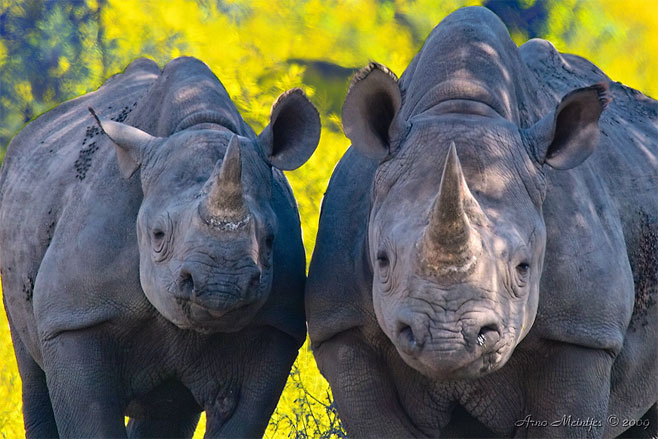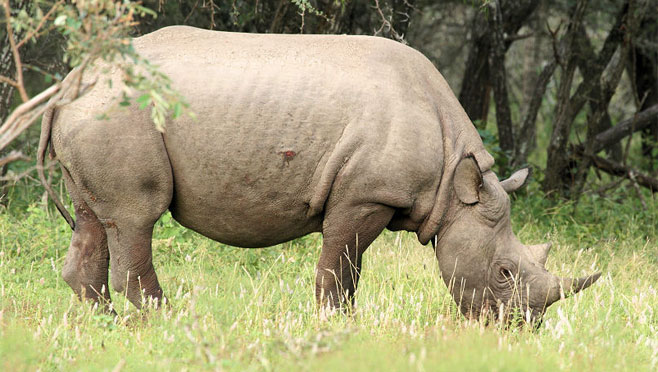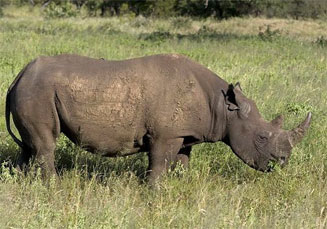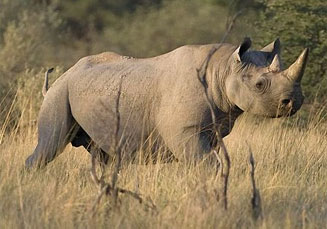|
Diceros bicornis (Hook-lipped rhinoceros, Black rhinoceros)
swartrenoster
[Afrikaans]; Spitzmaulnashorn [German]; rhinocéros
noir [French]; faru [Swahili]; umkhombo, ubhejane onzima, umkhombo onzima [isiNdebele];
umkhombe [isiXhosa]; ubhejane, isibhejane [isiZulu]; makgale [Sepedi]; tshukudu,
tshukudu e molomo wa haka [Sesotho]; bodilê, tshukudu, bodilênyane, kenenyane [Setswana];
chipenbere, nhema [Shona]; sibhejane [siSwati]; mhelembe, mhelemba [Xitsonga];
thema, thema i re milomo mitshena [Tshivenda]; sukulu [Lozi]; unshunguzu [Yei];
!Nabas [Nama] [Damara]; ngara [Herero]; khi [San]
Life
>
Eukaryotes >
Opisthokonta >
Metazoa (animals) > Bilateria > Deuterostomia >
Chordata > Craniata > Vertebrata (vertebrates) >
Gnathostomata (jawed vertebrates) > Teleostomi (teleost
fish) > Osteichthyes (bony fish) > Class:
Sarcopterygii (lobe-finned fish) > Stegocephalia
(terrestrial vertebrates) > Reptiliomorpha > Amniota >
Synapsida (mammal-like reptiles) > Therapsida > Theriodontia
> Cynodontia > Mammalia (mammals)
> Placentalia (placental mammals) >
Laurasiatheria > Ferungulata > Paraxonia > Perissodactyla (odd-toed
ungulates) > Family: Rhinocerrotidae
(rhinoceroses)
 |
|
Hook-lipped rhinoceros, Kruger National Park,
South Africa. [photo Arno Meintjes
©] |
 |
|
Hook-lipped rhinoceros, Kruger National Park,
South Africa. [photo
Dave Scott
©] |
 |
 |
|
Hook-lipped rhinoceros, Thornybush Game Reserve,
South Africa. [photo Trevor Hardaker ©] |
Hook-lipped rhinoceros, Tswalu Kalahari Reserve,
South Africa. [photo
Trevor Hardaker ©] |
Identification
The Hook-lipped rhinoceros is also frequently
called the black rhino, because of its darker grey colour. There is
no large hump on the neck and the head is shorter than the
square-lipped rhino, ending in the characteristic triangular
prehensile “hooked” upper lip. There are two horns above the nose
usually the front horn is longer. The rhinoceros gets its name from
the Greek meaning “nose-horn”. The rhino’s horn has no core and
consists of a matted aggregation of hair-like keratin fibres, seated
on a roughened area of the nasal region of the skull. Short stout
limbs support the animal’s massive weight and the feet have 3
digits. The rhino is one of Africa’s “Big Five”.
Size
Height at shoulder 1.6 m; weigh range 800
– 1100 kg
Dental formula
I C C P P M M =
24 =
24
Distribution and habitat
Previously had a wide distribution
throughout the southern African subregion but its natural
distribution is limited to some Zululand reserves. Its distribution
is now limited to reserves and game farms. It occupies a wide range of habitats that
provide shrubs and trees of up to 4m in height with dense thickets
for resting.
General behaviour
Rhino’s have poor vision and are unable to see
a motionless person at 30 m. However, their sense of smell is
excellent. The black rhino has a reputation for being bad-tempered
and unprovoked aggression. Because of their poor eye sight their
charges are usually blind rushes intended to scare of intruders.
Although they appear cumbersome, for large animals they are
surprising agile and fast.
Rhinos are dependant on upon water, although
the hook-lipped rhino can go for several days without water in more
arid habitats. They also use waterholes for wallowing, and coat
themselves in mud. It is thought that the mud serves to protect the
animal against biting insects. Although rhino’s have thick hides,
the blood vessels lie just below the thin outer layer.
Male rhino’s are solitary and territorial.
While usually solitary female black rhino will acquaint themselves
with other females that share their home range. Small groups may
collect together at water sources.
Food
Hook-lipped rhinos are browsers, feeding on
twigs and shoots. Their prehensile upper lip is ideal for grasping
the branches and twigs of woody shrubs and trees.
Reproduction
The calves are born after a gestation period of
15 months. Calves are vulnerable to attack by many predators
including lions and hyenas. The hook-lipped rhino calf walks
alongside or behind its mother. They will stay with their mother’s
for 2-3 years, until shortly before the birth of the next offspring
when she will drive them away.
Life span
40 years
Conservation
The rapid decline in numbers of both
African rhino species is a result of extensive poaching for their
horns. The horns are sold on the black market, most go to Yemen and
Asia. In Yemen the horns are carved into dagger handles, and in Asia
they are ground for use as traditional medicine. The best chance for
survival seems to lie in armed protection, their attraction in terms
of tourist revenue and protection in nature reserves and parks.
Their conservation status is critically endangered and all rhino are
listed on CITES Appendix 1.
|
